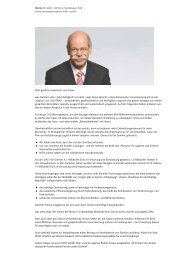Dear readers, This report describes what Daimler means by ...
Dear readers, This report describes what Daimler means by ...
Dear readers, This report describes what Daimler means by ...
Create successful ePaper yourself
Turn your PDF publications into a flip-book with our unique Google optimized e-Paper software.
<strong>Daimler</strong> 360 GRAD - FAKTEN zur Nachhaltigkeit 2008<br />
<strong>Daimler</strong> Nachhaltigkeitsbericht 2008 / Environmental protection, innovation, and safety / Activities and goals<br />
Fleet consumption<br />
Goals Activities/status Goal<br />
Regardless of <strong>what</strong> form the EU’s<br />
draft legislation on reducing CO 2<br />
emissions in new vehicles ultimately<br />
takes, <strong>Daimler</strong> will implement<br />
measures to further lower such<br />
emissions for its vehicle fleet in<br />
Europe, in order to meet the EU’s<br />
fleet consumption objectives.<br />
<strong>Daimler</strong> aims to be “best in class” in<br />
terms of the CO 2 emissions of its<br />
vehicles. Beginning in 2007, the<br />
Group plans to introduce at least<br />
one vehicle per year in each of the<br />
large-volume series (S-, C -, E-, A-<br />
/B- and M-Class and smart) with<br />
CO 2 emissions significantly lower<br />
than those of the respective<br />
predecessor model from 2006.<br />
Reductions will total at least<br />
8 percent for the small-car segment<br />
(smart, A-/ B -Class) and at least<br />
15 percent for the middle and<br />
upper-range segments.<br />
Our efforts to reduce fuel consumption will be further intensified.<br />
Here, downsizing and turbocharging will play an important role<br />
with regard to the engine. The principal measures include:<br />
� rollout of direct gasoline injection in our four-cylinder<br />
gasoline engines as of 2010 (consumption reduction<br />
potential approx. 10 percent) – this technology has already<br />
been available in the CLS 350 since 2006 and the E 350 CGI<br />
since 2007 and will be available in the C350 CGI <strong>by</strong> the end<br />
of 2008.<br />
� introduction of start-stop systems, initially in the smart<br />
(2007), followed <strong>by</strong> the A-/B-Class (consumption reduction<br />
potential approxiamately 8 percent);<br />
� four-cylinder gasoline and diesel engines with optimized<br />
consumption as of 2008/2009 (savings potential 5 –<br />
10 percent);<br />
� development of the so-called DIESOTTO concept<br />
(consumption reduction potential of 15 – 20 percent) – 1st<br />
stage <strong>by</strong> 2012;<br />
� improvement of energy management (5 –10 percent)<br />
Compared with the reference year 1995, the average fuel<br />
consumption of Mercedes vehicles has been reduced <strong>by</strong><br />
21.3 percent as a result of various measures; this reduction rate<br />
is almost 50 percent higher than the ACEA average.<br />
We are employing technical measures to improve the efficiency of<br />
the drive train – e.g. new combustion processes. The fuel<br />
consumption of the gasoline engine with stratified direct<br />
injection, also available in the E-Class since 2007, is around<br />
10 percent lower. The high injection pressure and newly<br />
developed seven-hole injectors of the latest-generation CDI<br />
engine, introduced in the new-generation smart fortwo in 2007,<br />
make for a 13-percent reduction in fuel consumption. With the<br />
launch of BlueEFFICIENCY vehicles (starting with the C-Class in<br />
2008) we will reach, and in some cases clearly surpass, our<br />
reduction targets for the medium and upper-range segments. The<br />
C 200 CDI BlueEFFICIENCY launched in April 2008 boasts a CO 2<br />
emission level 17 percent lower than that of the predecessor<br />
model, and the CO 2 emissions of the C 180 KOMPRESSOR<br />
BlueEFFICIENCY (also launched in April 2008) have been reduced<br />
<strong>by</strong> 15 percent.<br />
attainment<br />
Further<br />
development of<br />
the current<br />
consumption<br />
goals for<br />
Europe<br />
Goal still<br />
applies<br />
Link<br />
Link<br />
Link<br />
Link














